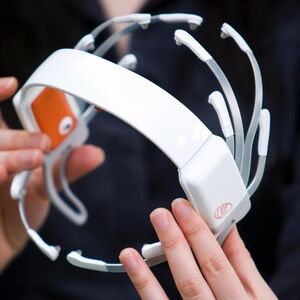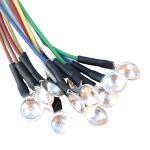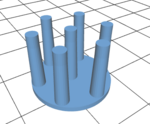Low Cost Electroencephalogram (EEG)
| Example EEG Device | |
| Sponsors | Dr. Gautam Kumar
|
| Team Name | Super Big Brain (SBB) EEG |
| Duration | Fall 2018 - Spring 2019 |
| Faculty Adviser | Dr. Feng Li
|
| Client | Dr. Gautam Kumar
|
| Team Members |
|
Problem Definition[edit | edit source]
In order to better educate high school students about brain function, we are developing an educational, low cost EEG that can be made in classrooms by students. During this year, we are going to determine the least expensive and most easily reproducible way to create and EEG for under $100.
Background[edit | edit source]
The biggest barrier to introducing high school students to basic neuroscience is the staggering cost of an EEG and the corresponding software. Instead of spending $800 on an EEG device like Emotive, and hundreds of dollars per month on the related software, this new EEG design will deliver open source software and instructions for an easily reproducible hardware design to open neuroscience and basic engineering to all high school students.
Specifications[edit | edit source]
| Design Area | Specification |
|---|---|
| Hardware |
|
| User Interface (UI) |
|
Design Considerations[edit | edit source]
| Design Area | Consideration |
|---|---|
| PCB Hardware |
|
| Microcontroller |
|
| User Interface |
|
Project Learning[edit | edit source]
Electrode Research[edit | edit source]
We have tested several different types of electrodes to use for the EEG. We bought a sample pack of medical grade gold cup electrodes in order to get a base line signal to compare our electrodes to. The main candidates that we have tested are silver cup electrodes, 3D printed electrodes, and DIY electrodes using metal plates. The table below shows the finding of our testing. From this testing we decided to use silver cup electrodes because they are less expensive than gold cup electrodes but measure the same quality of signal.
| Electrode Type | Pros | Cons |
|---|---|---|
| Gold Cup |
|
|
| Silver Cup |
|
|
| 3D Printed |
|
|
Signal Research[edit | edit source]
The EEG signals are voltage fluctuations resulting from the currents produced by neurons in the brain. These EEG signals have very small magnitudes, typically around 50μV. The frequencies of the EEG signals that we are measuring range from 1Hz-50Hz. The following table describes the ranges of frequencies of EEG signals.
| Frequency Range | Description |
|---|---|
| Delta (0Hz-3Hz) | Delta waves to be the highest in amplitude and the slowest waves. They are normal as the dominant rhythm in infants up to one year and in stages 3 and 4 of sleep. It is usually most prominent frontally in adults. |
| Theta (3Hz-8Hz) | Theta waves are classified as "slow" activity. They are perfectly normal in children up to 13 years and in sleep but abnormal in awake adults. |
| Alpha (8Hz - 13Hz) | Alpha waves appears when closing the eyes and relaxing, and disappears when opening the eyes or alerting by any mechanism (thinking, calculating). They are the major rhythms seen in normal relaxed adults. They are present during most of life especially after 13 years old. |
| Beta (13Hz - 30Hz) | Beta waves are the high frequency waves most commonly found in awake humans. They are channeled during conscious states such as cognitive reasoning, calculation, reading, speaking or thinking. |
Hardware Research[edit | edit source]
Instrumentation Amplifiers[edit | edit source]
The instrumentation amplifier is a differential amplifier that amplifies the difference between a channel input and the reference signal. It also reduces common mode noise from the signals. There will be 1 instrumentation amplifier per channel.
Filters[edit | edit source]
The signals from the electrodes are very noisy. The biggest source of noise that we have found is 60Hz electrical hum from the power system. This frequency is very close to the frequencies that we are attempting to measure which makes it difficult to remove. This noise reduces measurement accuracy therefore, it needs to be removed. We are removing the noise by using a low pass filter with a cutoff frequency of 55Hz. In order to have a steeper roll-off, we are using a Chebyshev filter.
Hardware Design[edit | edit source]
| Stage | Description |
|---|---|
| Current Limiting Resistors | The electrodes are prone to a build up of a high DC voltage and ESD voltage that could potentially damage the instrumentation amplifier. The current limiting resistors are used to prevent large currents from entering the inputs of the instrumentation amplifier. |
| Instrumentation Amplifier | The instrumentation amplifier (in-amp) is used to remove the common mode noise between the channel and the reference node. The amplifier also amplifies the differential signal by 12. The extra noise from contact with skin and other sources will be removed and the signal on the output will be the amplified EEG signal from the channel. |
| High Pass Filter | Electrodes are susceptible to a phenomenon called "Electrode Polarization", where a large DC voltage is built up on the electrode. Therefore, a high pass filter with a very small cutoff frequency is implemented after the in-amp to remove the DC voltage before the signal is amplified. If the DC was amplified, it could potentially damage the circuit. |
| Non-Inverting Amplifier | An amplifier with a gain of 50 is used to amplify the signal. After the amplifier, the signal will have an amplitude of ~50mV. This will allow the ADC to measure the changes in the signal with more precision. |
| Low Pass Filter | In order to prevent aliasing when sampling the signal with the ADC, a low pass filter is used to remove any high frequencies above 100Hz. Aliasing would cause the signal to be distorted and would change the frequency components. |
| Buffer | An ADC is a large capacitive load that could affect the performance of the opamps if connected directly. Therefore, a buffer is added between the output of the filters and the ADC. |
The channel input signal used for the LTspice simulation is a 100µV, 50Hz sine wive added to a 10mV, 10kHz sine wave to represent the EEG signal and the common mode noise.
The resulting output signal is a 50Hz signal with an amplitude of ~60mV. This is what we would expect from a 100µV, 50Hz input signal.
Team Members[edit | edit source]
|
Name: Corey Knapp | |
|
Name: Allison Ellingson
| |
|
Name: Yiting Gao | |
|
Name: Ostin Arters
|
Additional Documentation[edit | edit source]
Project Schedule
Meeting Minutes
9/6 Meeting Minutes
9/13 Meeting Minutes
9/20 Meeting Minutes
9/25 Meeting Minutes
10/2 Meeting Minutes
10/16 Meeting Minutes
10/23 Meeting Minutes
10/30 Meeting Minutes
Presentations
Client Interview












